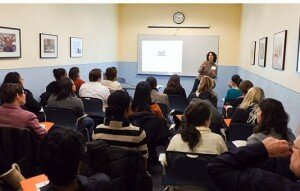by Laura Raines
Originally published on May 6, 2010 for the Atlanta Journal Constitution and cross posted here with permission from the author.
For many years, Steve Perry was a top sales performer in corporate America. As Southeast area manager for Gartner, the leading information technology research and advisory company, he was also a leader for charitable causes. Perry led the United Way campaign for his division and later joined the board of TechBridge, a nonprofit organization that provides IT advice to other nonprofits.
He found himself more drawn to philanthropy and fund-raising. “I loved the intangible feeling that you get when you help another person. It was time for me to evolve my career,” he said.
Perry left the profit sector, but before beginning his nonprofit search, he enlisted the help of Ellen McCarty, president of Ellen McCarty & Co. and a consultant who helps nonprofit organizations be sustainable and individuals considering a switch to the nonprofit sector.
“I knew I had a passion for philanthropy and a lot of useful business experience, but I needed to learn the landscape of the nonprofit world,” Perry said. “She showed me that the pursuit of my dream job was not only possible, but probable.
“At the heart of me, I want to make a difference, and my business side says that working with donors to raise more money is a way to do that. I know that I can put my skills to work for a great cause.”
There are 1.5 million nonprofit organizations in the country, and the number is growing, according to McCarty, “so the nonprofit sector is a very viable career path. In the short run, nonprofit employment has been hurt by the economy, but in the long run, there’s great opportunity.”
“There’s real need because most nonprofit senior executives are older and nearing retirement. The conservative estimate is that 330,000 senior-level positions will need to be filled by 2016,” she said. “For sheer employability, now is an excellent time to consider nonprofits.”
Before starting her consulting business, McCarty served as executive director of the Center for Children and Young Adults Inc. in Cobb County and of Jerusalem House in Atlanta, and as CEO of the Make-a-Wish Foundation of Georgia and Alabama.
Nonprofits often turn to the private sector to find people with the strategic thinking, planning, financial, project management and human resource management skills they need to be effective. McCarty hired a Wharton graduate with Wall Street experience as the chief financial officer at Jerusalem House, needing her knowledge of financial systems, cash flow and forecasting. Nonprofits also need people with strong sales skills. “The only difference is what you’re selling: Instead of a product, you’re selling the mission of the organization,” she said.
Since the recession, McCarty is seeing more workers wanting to end their careers doing something that makes a difference. “The No. 1 reason people say they want to switch is because they want to work for purpose,” she said.
That doesn’t mean that everyone is a good fit for the nonprofit culture. Some people are too competitive to mesh with a more collaborative environment where decisions take longer. McCarty helps clients decide using the CROP method, which stands for Clarify (one’s motivation), Reflect (on the types of organizations where your skills would fit best), Organize (your interests with the types of nonprofits that would best fit) and Plan (your search).
“The National Center for Charitable Statistics organizes nonprofits into nine sectors. People have to figure out if their passion lies in health, the arts, human services or the environment, for instance, and whether they’d fit better with a large organization or a grass-roots effort,” she said.
They also have to get past some of the myths associated with nonprofits, such as the environment is nicer, slower and less stressful. “The truth is that you don’t always have the resources you need and you wear many hats. It can be fast-paced and political, but at the end of the day, you know there’s a human face affected by what you do. That’s stressful,” said McCarty. “You won’t be poor working for a nonprofit, another myth, but in all likelihood, you’ll earn less.” She said that, on average, entry-level positions paid 5 percent to 10 percent less; midlevel positions 25 percent less; and executive level, 50 percent less.
“It’s best to educate yourself about the sector and all its choices, so you can make an informed decision,” said McCarty.
 Who is in charge of managing volunteers? Is there a process in place for handling new volunteers? Ensuring that volunteers are appropriately assigned and supported is a collective responsibility, and everyone understands how their piece relates to the whole.
Who is in charge of managing volunteers? Is there a process in place for handling new volunteers? Ensuring that volunteers are appropriately assigned and supported is a collective responsibility, and everyone understands how their piece relates to the whole.



